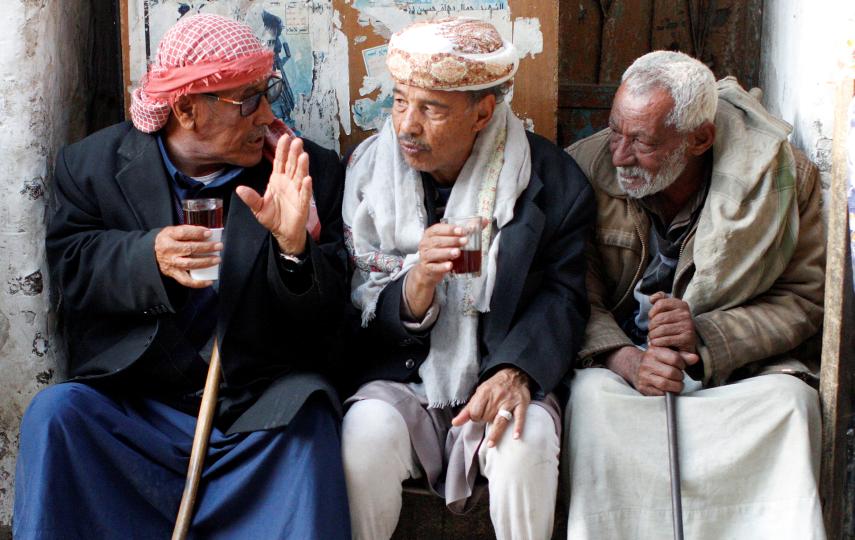In India, its dried leaves are used as a hair conditioner; in east Africa it’s fed to livestock; Mauritanians smoke its seeds; and in rural Senegal, where it goes by the name of leydour, its medicinal uses are helping many make up for the agricultural losses brought about by climate change.
Senna (or Cassia) italica is a deciduous perennial herb that can be harvested year-round – one of the reasons its cultivation is catching on in parts of Senegal.
Farmers in Nioro du Rip, a department in the central Kaolack region, have traditionally grown groundnuts, millet, and maize, but recent years have seen revenue from these crops fall.
More than 300 women in three villages in the commune of Kaymor are compensating by growing the shrub on a large scale.
Bocar Dioum, the former head of the commune’s health department, now runs agricultural training activities in the Kaymor area.
“Leydour, which plays a part in social mobility, has radically changed the economic and health conditions of women in Kaymor,” he told IRIN.
“Faced with the drop in agricultural revenue due to climate change, and the high number of consultations at the health centre, we have found an answer in the revival of medicinal plants, specifically, leydour.”
Many uses
In Senegalese traditional medicine, the leaves, pods, and mature seeds of leydour are used to cure stomach complaints, fever, jaundice, venereal diseases, and biliousness. The plant is also prescribed as a cure for intestinal worms, while its leaves are used as a dressing for skin problems such as burns and ulcers.
“A hectare of leydour brings in much more money than two hectares of millet or groundnuts, with much less financial investment or physical effort,” explained Cheikh Ndiaye, a local village chief.
“Leydour leaves can be harvested every two months, whereas millet and groundnuts are seasonal,” he said. “A kilo of leydour sells for much more (1,500 CFA francs/$2.6) than all the other crops here.”
Fatou Deme heads an association of 115 women growers in Keur Samba Die and two other villages in the Kaymor commune.
“The consumption of this plant has noticeably improved the health of the villagers,” she explained. “We go ever less frequently to the health centre in Kaymor. The other advantage is that we sell it, and the revenue helps us meet certain needs.”
Impact of climate change
Agriculture, which forms the backbone of the rural economy in Senegal, has been severely affected by climate change and the situation is only expected to get worse.
According to Ibrahima Hathie, research director at the Initiative Prospective Agricole et Rurale, a Dakar-based institute that conducts research and training in agriculture, temperatures in central Senegal are set to rise by between 1.5 and 1.75 degrees by 2050, while rainfall will decline by 20 to 30 percent.
“Inhabitants of the Sahel region feel the effects of climate change on a daily basis. They impact food security and access to water, and degrade ecosystems,” said Souleymane Diallo, chief of staff in the Ministry of Environment and Sustainable Development. “So it’s important to take steps that limit the effect of climate change on agriculture and its consequences for food and nutritional security.”
Eying new markets
Deme told IRIN that the Keur Samba Die collective, which has 25 members, had brought in 215,000 CFA francs ($370) this year through leydour cultivation.
“Some of this is saved in a bank account and we share out the rest among members,” she explained. “It really does provide financial help and we have an interest in keeping up the cultivation of leydour in our village,” she said, adding that she hoped to find new markets with the help of government bodies and the private sector.
Deme’s marketing ideas include better labelling to indicate the plant’s geographical origin as well as its various benefits.
The potential market extends well beyond Senegal: In many parts of the world, the crushed, dried leaves of the leydour plant are sold, including on major online trading platforms, as a hair-conditioning product called “natural henna”.
And the production process doesn’t take long: Two months after planting a leydour seed, one can begin harvesting its leaves, dry them, and sell them.
Going organic
“We don’t use any fertiliser or chemical pesticides. Everything is organic,” said Deme, adding that oil from the neem tree is used to stop parasites attacking the shrubs.
Growing leydour benifits the whole village, added another member of the association, Aissatou Toure. “We use it as a medicine and treat our animals with it. Now, other villages are following in our footsteps.”
Ndeye Ndiaye Toure, who heads a growers’ association of 70 women in the village of Passy Kaymor, said cultivating the shrub had turned their lives around.
“Of course we grew vegetables,” she said. “But we needed money to buy seeds and other inputs. But leydour requires no real financial investment. We use it as medicine and make more money. We grow it together with totally organic market garden produce. It’s a real plus for us women.”
The dried and powdered leaves of the leydour plant are sold to herbalists for 1,500 CFA francs per kilo, of which the collective lodges 375 francs in a common kitty.
“We manage to save 500,000 CFA francs after each harvest that we use to support the needs of our members, for religious festivals for example, or when someone has an occasional need for money,” said Toure. “What’s more, we’re able to buy groundnut seeds for our husbands who reimburse us after their harvests.”
Impressive yields
The men of Passy Kaymor were initially sceptical of the leydour project, recalled Kany Toure, who said that it didn’t take long for the village’s women to show they could harvest the plant’s leaves in significant quantities, even if the very first harvests only amounted to about 10 kilos.
Yields began to take off after communal land in the village was divided into individual plots for each member of the cooperative.
Kany Toure pointed to an added benefit: “Leydour put an end to the cutting of trees, which we used to sell to feed ourselves. Nowadays, we are standing on our own two feet.”
She added that the annual production of dried leydour leaves could soon reach a record quantity of around 500 kilos in Passy Kaymor alone.
The success of leydour in the area has spread to other parts of the department, and even beyond the Kaolack region, as its pioneers have lent their know-how to other parts of Senegal.
(TOP PHOTO: A woman in the commune of Kaymor shows leaves of the leydour plant. Cissokho Lassana/IRIN)
cl/am/ag





